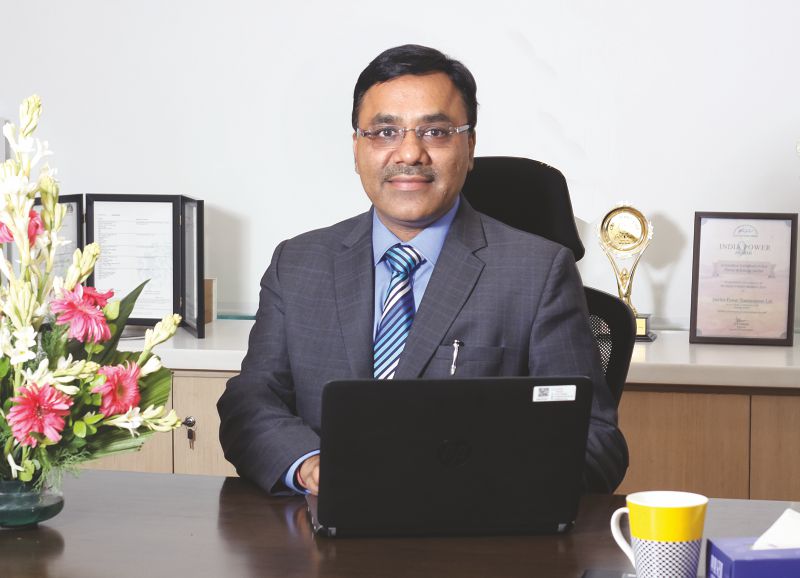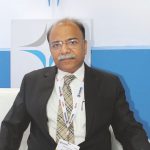Sterlite Power participated in the transmission auction held by the Brazilian Government in the third week of December 2017, and won the largest lot of the auction of ~ USD 800 million. The 1800 km transmission project represented one-third of the total auction value, making way for the largest investments by an Indian company in Latin America. Offering many end-to-end solutions for various transmission projects, the company also expanded its conductors and cable portfolio with the development of 220 KV underground power cable.

“On the product side, we are the leading Indian player in the high-performance conductor business. Currently, we are supplying products to leading utilities in India, and exporting to over 40 countries across the globe. We have four state-of-the-art manufacturing units, where the focus is on developing products for the Indian as well as export markets. In cables business, we have recently developed 220 KV power cable with optical fiber technology to sense the point of temperature variance. By locating the exact place, one can remedy the cause,” said Mr. Manish Agarwal, CEO, Solutions Business – Sterlite Power in an interview with Wire & Cable India.
Wire & Cable India: To start with, tell us some recent developments at Sterlite Power.
Manish Agarwal: We are into power transmission, and within power transmission, into infrastructure and solutions. Sterlite Power is also India’s leading private sector independent power transmission infrastructure owner. In the infrastructure, we have recently ventured into Brazil where we have got some large projects, which makes us the first Indian company to invest in Brazilian transmission projects. That’s something very new and exciting.
Solutions business comprises products and projects on turnkey basis. On product solutions side, Sterlite Power again is the leading manufacturer of power cables, power conductors and OPGW. We are launching three new products in overhead and underground cabling solutions, which are in sync with the latest technology. Sterlite Power is spearheading the Indian market in high-performance conductor solutions, and it has recently developed the 220 KV underground power cables.
On project solutions side, we also undertake bespoke MSI (master system integration) projects, scope of which includes upgrading, uprating, strengthening the existing power delivery networks, instead of building new lines. We have done such bespoke projects in many states. Only recently, we have acquired INR 500 Cr order of this nature from Kerala, where we are doing upgrade and uprate jobs on the existing lines. To give you a scope of the job we are doing here, we are changing normal tower to multi-circuit tower and the earth wire to OPGW along with upgrading the 110 KV line to 220 KV. Within that project, there are lines which need more ampacity, which we are uprating.
These are some of the things we are doing in solution and infra business sides in the transmission area. Our utmost focus on technology continues and we are always developing end-to-end solutions for utilities keeping in mind their time, space and capital constraints.
WCI: When you get an update/uprate project for the existing transmission corridors, what are the challenges you face in terms of revamping the older system as per the latest needs?
MA: India has limited land. Therefore, if you are thinking of building a new transmission line, RoW and forest environment clearances are taking as many as 2-3 years for approvals. In this background, revamping the existing lines looks more attractive because of fewer challenges as compared to building the new corridors. We have successfully undertaken a number of such projects in various states during the last couple of years, where we have doubled the capacity and upgraded the voltage for the same corridors. Our upgrade/uprate work can do so much with the existing infrastructure that it becomes good for 15-20 or even 30 years. I even expect support from the Ministry of Power through a policy initiative, which looks in to giving a thrust on uprating and upgrading of the existing corridor while pushing for new infrastructure.
Talking about challenges in upgrading the older lines, foremost is the limited time during the day to get the job done. You get a window of a couple of hours every day for the work. If suppose you are doing reconductoring then you need to change the conductor or work on the transmission line within that 2-hour window and give the system back to the utility for them to resume operations. That’s quite challenging because many a time you are not able to get the adequate shutdown time. Sterlite is going to offer its customers a kind of minimal to zero shutdowns, by working on the charged lines and changing the conductors to a high-performance conductor with almost zero shutdowns. We are bringing those technologies which will help utilities in minimizing the losses during shutdown period when power transfer is not happening.
WCI: Can you enumerate the challenges when you are tasked to build new transmission corridors?
MA: I can see the improvements in the government clearances with regards to forest and environment. Still, I think our country needs to do much better in terms of those clearances. Around 4-5 years back, there was a time when Power Grid was building transmission lines in lot more time than desired or needed. And, Sterlite has now demonstrated by taking up the projects that transmission lines can be built within 18-20 months of time. You don’t need 3-5 years. That we have done with government’s support and on-time clearances. There have been improvements, but a lot more can be done by the Government.
WCI: Sterlite is the leader in T&D infrastructure and solutions as known. Please explain how!
MA: Within solutions, we have overhead and underground cabling business, and in both, we are focusing on transmission and sub-transmission. On the transmission related manufacturing and supply side, we are one of the largest suppliers of conductors in India. About two years back, around 25 percent of the country’s grid was running on Sterlite’s conductors. We play a pivotal role when it comes to conductors and it holds true today as most of the grid runs on Sterlite conductors.
WCI: Coming to the solution itself, will you please summarize what kind of solutions you have right now and what kind of new developments are happening there?
MA: Solution business comprises of products – conductors, high-performance conductors, OPGW, and EHV underground cables – and turnkey jobs/projects in terms of uprate and upgrade of networks. We are doing new things in both of these sub-segments of our solutions business. On the uprate and upgrade front, we are coming up with new technologies and ways to deliver the customer end-to-end solution with a minimal or no shutdown.
On the product side, we are the leading Indian player in the high-performance conductor business. Currently, we are supplying products to leading utilities in India, and exporting to over 40 countries across the globe. We have four state-of-the-art manufacturing units, where the focus is on developing products for the Indian as well as export markets. In cables business, we have recently developed 220 KV power cable with optical fiber technology to sense the point of temperature variance. By locating the exact place, one can remedy the cause.
We are also looking at application of robotics in OPGW solutions, where we have developed a solution and have applied for the patent. We are mostly changing the earth wire to OPGW on charged lines, where you need to complete the job a lot faster with all safety precautions. With robotics, we will be able to do the network replacements at a much faster speed, maybe 3 times the conventional speed and with a lot more safety.
WCI: Underground cabling is catching up fast. Can you tell us few of its advantages over traditional overhead lines?
MA: The underground power cable shows a CAGR of 10-12 percent. This is bound to happen because most of the overhead networks in the big cities or the metros will go down eventually. Besides, the concept of smart cities is also giving a push to underground cabling solutions. In urban clusters, especially in metros and big cities, efficacy of underground cable over overhead lines can be understood as RoW through populous areas remains a big concern. Therefore, there is a lot of potential in metros or big cities for underground power cable networks. A high growth in underground power cable segment is visible and we are much focused there, especially in high voltage and extra high voltage. That’s the space where we will offer our solutions.
Another unique thing about Sterlite is that we are offering the customers the mix of overhead and underground. Imagine, a customer had to change the conductor from place A to C, but there are bridges and roads coming in between. Underground cabling is the solution here.
WCI: Your other company Sterlite Tech is focusing comprehensively on the smart city by providing end-to-end solutions in more than one area. Does Sterlite Power also have something to offer to the concept of the smart city?
MA: Yes, you have rightly mentioned that Sterlite Technology Ltd is doing work for a couple of smart cities. We have also been thinking of working on smart cities by looking at how we can convert the overhead old networks into underground networks along with digitization of substations. This is something we are focusing upon and have solutions around. Sterlite, you will shortly see, will be focusing on building underground networks, making cities smarter through a smarter network based on the underground power cable, digitization, etc.
WCI: Tell us more about the overseas projects which you have secured in Brazil.
MA: We acquired one project in Brazil last year, which is an INR 5000 Cr transmission line building project and is a big commitment for us. In Brazil also, there are a lot of clearances required before you start the project and the way of working is a little different from India. We are in the process of getting clearances. We are working well in that market and plan to invest more in such markets because there are enormous opportunities. Apart from Brazil, we have been looking at some more countries that I cannot tell you right now. Certainly, we are keen in investment in transmission projects outside India. We keep on evaluating the options and you will see us bidding in different countries in times to come. Also, in the solution business, we have done things in India till now and we are now thinking of going outside in the next couple of years.
WCI: What are your views on the prospective growth of the Indian wire and cable industry?
MA: It is looking quite positive. I was reading that the global demand is going to increase by 13-14 lakh of circuit km of conductors or cables in the next 7-8 years and that’s definitely a very good sign. I believe India has a lot of potential to export conductors, cables and high-performance conductors. However, on ground, there has been a slower growth in the last 2-3 years. The capex delivered year-on-year in most of the states shows a big gap.
I see that everything cannot be dependent on the Central Government. Yes, of course, CEA and CTU must now see whether we are going to be transmission ready with so much RE coming in, especially when there is a gestation period of 3-4 years for a transmission line and one year for a RE plant. India therefore should be more focused on transmission planning and put proper networks in place for power evacuation. There has already been a lot of focus on generation and distribution, which I think will help the country. Besides, the state governments will have to take lot more initiatives and adopt business models like TBCB for transmission projects, which will help them on the funding side along with companies doing projects much faster.
WCI: Few final words on behalf of Sterlite Power!
MA: At Sterlite Power, the impetus for focus is on technology and talent. Those are two big pieces we are working upon besides digitization and other things. And, in infra business, whatever we can do for the country, we will do. We have built projects in the shortest possible time and that will continue. We are working closely with various states. Jharkhand is the first state where they have taken a big leap in terms of announcing projects with tenders along TBCB route. I would say that other states should follow the suit.
On solution side, Sterlite will be very focused around bringing and building newer solutions in sync with the latest technological requirements.




